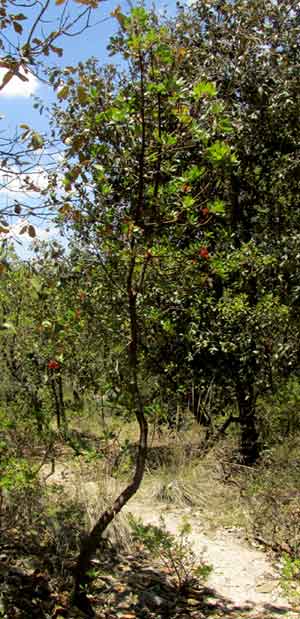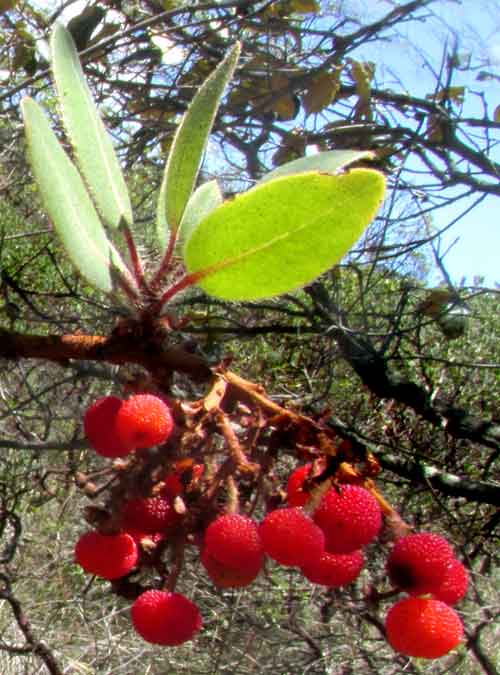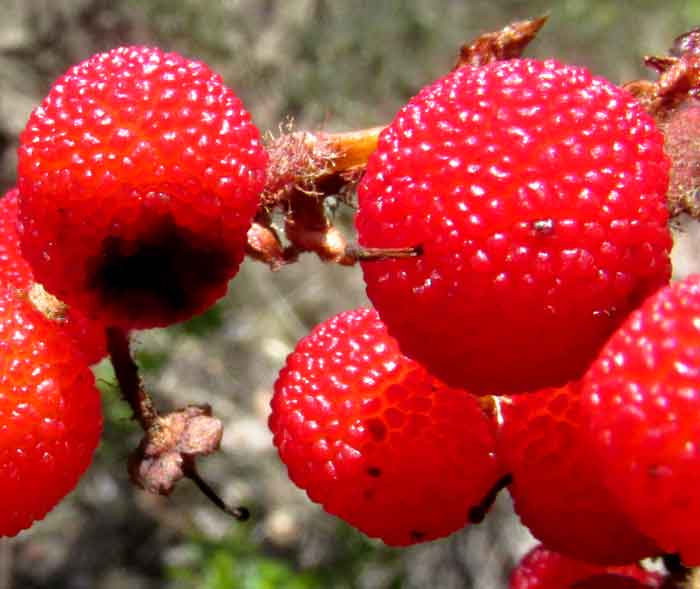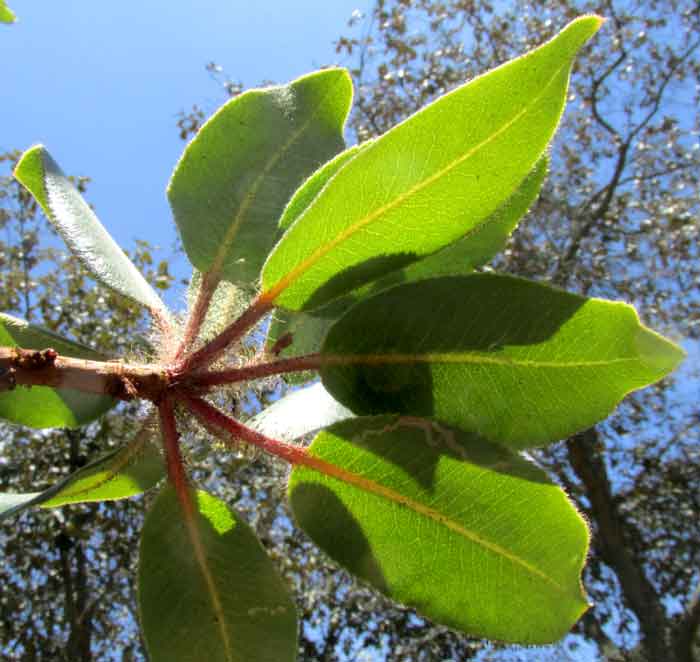Excerpts from Jim Conrad's
Naturalist Newsletter
entry from field notes dated July 2, 2022, taken on the eastern lower slope of Cerro de la Cruz, at an elevation of ~2700m (~8850 ft), just south of the community of El Pinar, Amealco de Bonfil, Querétaro, MÉXICO, (~N20.17°, ~W100.17°)
MADRONE
 On the lower eastern slope of Cerro de la Cruz, where the slope's oak forest transitioned into a large abandoned field covered mostly with scattered shrubs and clumpgrass, a small tree grew along the trail. This year the rainy season hasn't come in May as it should have, so the grass was still gray/brown and crispy, but the tree looked green and healthy, as shown at the right. What caught my eye about the tree was that several branches bore clusters of bright red fruits like those shown below:
On the lower eastern slope of Cerro de la Cruz, where the slope's oak forest transitioned into a large abandoned field covered mostly with scattered shrubs and clumpgrass, a small tree grew along the trail. This year the rainy season hasn't come in May as it should have, so the grass was still gray/brown and crispy, but the tree looked green and healthy, as shown at the right. What caught my eye about the tree was that several branches bore clusters of bright red fruits like those shown below:

The fruits were about thumbnail size, one cm across (25/64 inch), somewhat juicy with an OK but not great taste, and each fruit contained several seeds. Technically such fruits are classified as berry-type fruits, for they are simple, fleshy fruits with more than one seed, and produced from the ovary of a single flower. That's not the concept of a berry by most, of course. According to that definition, tomatoes are berries, which, technically, they are. Moreover, blackberries, blueberries and strawberries aren't technically berries. Whatever the case, the noteworthy feature of these fruits is shown below:

They were bumpy, or "tuberculate." Such a combination of vividly red, bumpy fruits on a broadleaf evergreen tree are distinctive and unforgettable. On dry wooded slopes in California and Oregon we've seen such fruits on the Pacific Madrone, and even in Europe there was the Strawberry Tree, also a different species, but both of those trees were members of the genus Arbutus, of the Heath Family, the Ericaceae, of azalea and rhododendron fame. And our Mexican tree's leaves do look a little like rhododendron leaves, even similarly clustered at branch tips, though they're not as thick and leathery:

However, our Mexican trees' leaves have a special feature I've never seen on any Arbutus species, shown below:

At least on the tree's younger leaves, long, gland-tipped hairs grew on the petioles. The hairs are of various lengths, up to about 7mm long (9/32 inch), somewhat soft and irregularly arranged, and their glands are reddish or yellowish. Apparently the glands' stickiness spreads to the lower parts of the hairs, for you can see how tiny particles adhere there, as well as the occasional small insect. If you're a caterpillar on a tree limb eager to eat new leaves at the branch's tip, you'd hesitate before marching across such such a mess.
Despite all the above features suggestive of the genus Arbutus, there's still some doubt to deal with. That's because there's another genus, Comarostaphylis, with several species in the area which are very, very similar to species of Arbutus, down to the fleshy, bumpy, sometimes-red fruits. However, fruits of Comarostaphylis species contain only one seed, while Arbutus fruits contain several. Our tree's fruits had more than one seed so here we do have an Arbutus.
In English, species of the genus Arbutus are known as madrones, based on the Spanish name for them, madroños. Arbutus is a small genus embracing only ten or so species. Three of those species occur in western North American while Mexico is home to seven, six of which occur in our upland, central Mexican Bajío region. And of those species, only one supplies its leaves' petioles with such long, glandular hairs, and that's ARBUTUS TESSELLATA.
Arbutus tessellata has no commonly used English name because it's endemic just to highland areas of western and central Mexico. It's found in a variety of forest types between elevations of 1700-3100m (5500-10,500 feet).
Though plenty of information about madrone species in general is available, there's little about Arbutus tessellata. One reason is that until 1987 it wasn't even recognized as a species, despite being the most commonly occurring one over much of its distribution area. Before 1987 many botanists had noted it, but they kept repeating the error of considering the trees as mere very glandular-hairy individuals of a species described in 1842. It just took Paul D. Sørensen at little Northern Illinois University to notice the tree's differences from that species -- its extremely long glandular hairs and the "checkered" bark on trunks of older trees -- and publish its description in a recognized botanical journal.
Sørensen considered the trees' rough bark, similar to that of the Alligator-bark Juniper, the species' best field mark. Most madrone species have smooth, reddish bark that readily exfoliates, like that of the Pacific Madrone we've seen in California and Oregon. Our young tree's bark hadn't yet developed blocky bark, but later, among rhyolite boulders at the chillier, windier top of Cerro de la Cruz, at about 2885m (9465 ft), where Arbutus tessellata hadn't yet developed fruits, an older tree's bark appeared as below. Note how toward the top the bark breaks into a patch of relatively smooth, red stem.

The Pacific Madrone is the best known madrone species in North America. The literature describes its honey-smelling flowers as very attractive to bees, and the resulting fruits as eaten by many birds and other wildlife. Traditionally an extract from the bark was used for tanning hides, and decoctions made from it was used medicinally to treat small wounds, and make an astringent tea used for upset stomachs and to treat colds. Its flavor has been described as a combination of cinnamon, mushrooms and wood smoke. The wood, though heavy and hard, is brittle, and cracks when drying, so it's not much used for building.
I suspect that these observations apply to most or all Arbutus species, including ours with its super-glandular-hairy leaf petioles.